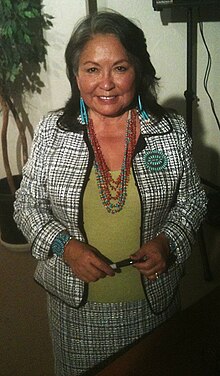Luci Tapahonso | |
|---|---|
 Tapahonso at
Diné College in 2011 | |
| Born | November 8, 1953 Shiprock, New Mexico, USA |
| Occupation | Writer, university lecturer |
| Education | B.A., English, U. of New Mexico |
| Genre | Poetry |
| Subject | Native American Studies |
Luci Tapahonso (born November 8, 1953) [1] [2] is a Navajo poet and a lecturer in Native American Studies. She is the first poet laureate of the Navajo Nation, succeeded by Laura Tohe. [3] [4]
Early life and education
Tapahonso was born on the Navajo reservation in Shiprock, New Mexico to Eugene Tapahonso Sr. and Lucille Deschenne Tapahonso. English was not spoken on the family farm, and Tapahonso learned it as a second tongue after her native Navajo. [5] Following schooling at Navajo Methodist School in Farmington, New Mexico, [6] she attended Shiprock High School and graduated in 1971. She embarked on a career as a journalist and investigative reporter before beginning her studies at the University of New Mexico in 1976. [5] There she first met the novelist and poet Leslie Marmon Silko, who was a faculty member and who proved to be an important influence on Tapahonso's early writing. She initially intended to study journalism at New Mexico, but Silko convinced her to change her major to creative writing. She earned her bachelor's degree in 1980. [7] In 1983, Tapahonso gained her MA in Creative Writing, [8] and she proceeded to teach, first at New Mexico and later at the University of Kansas, the University of Arizona, and the University of New Mexico. [6] [7]
Writings
Silko helped Tapahonso publish her first story, "The Snake Man", in 1978. [7] Her first collection of poetry, One More Shiprock Night (written when she was an undergraduate), was published in 1981, but did not make much impact. [5] Following Silko's lead, Tapahonso's early work is often mystical and places much importance on the idea of the feminine as a source of power and balance in the world. She also frequently uses her family and childhood friends in her poetry. Several more collections followed, as well as many individual poems which have been anthologized in others' collections, activist literature, and writing in magazines. [7]
Her 1993 collection Saánii Dahataal (the women are singing), written in Navajo and English, was the first to receive international recognition, a reputation then cemented by blue horses rush in a book of poetry and memoirs published in 1997. [7]
In 2008 Tapahonso published A Radiant Curve, which won the Arizona Book Award for Poetry in 2009. [9]
Tapahonso's writing, unlike many Native American writers, is a translation from original work she has created in her tribe's native tongue. Her Navajo work includes original songs and chants designed for performance. For this reason, her English work is strongly rhythmic and uses syntactical structures unusual in English language poetry. [5]
Awards
- Awarded the title of Poet Laureate of the Navajo Nation, 2013 [9]
- Arizona Book Award for Poetry, New Mexico Book Coop, 2009 [9]
- Lifetime Achievement Award, Native Writers' Circle of the Americas, 2006
- Wordcraft Circle Storyteller of the Year (Readings/Performance) Award, 1999
- Award for Best Poetry from the Mountains and Plain's Booksellers Association, 1998
- New Mexico Eminent Scholar award, New Mexico Commission of Higher Education, 1989
- Excellent Instructor Award, U. of New Mexico, 1985
- American Book Awards, Honorable Mention, 1983 [10]
- Southwestern Association of Indian Affairs Literature Fellowship, 1981 [3]
See also
- List of Native American women of the United States
- List of writers from peoples indigenous to the Americas
- Paula Gunn Allen
- Sherwin Bitsui
- Joy Harjo
- N. Scott Momaday
- Irvin Morris
- Simon J. Ortiz
References
- ^ Tillett, Rebecca (1 August 2001). "Luci Tapahonso". The Literary Encyclopedia. Retrieved 14 May 2014.
- ^ "Tapahonso, Luci 1953-". lccn.loc.gov. Library of Congress. Retrieved 14 May 2014.
- ^ a b "Luci Tapahonso Named as Navajo Nation's First Poet Laureate". Indian Country Today Media Network. 30 April 2013. Archived from the original on 21 August 2013. Retrieved 14 May 2014.
- ^ White, Kaila (25 September 2015). "ASU professor Laura Tohe named Navajo Nation's second poet laureate". The Arizona Republic. Retrieved 6 August 2016.
- ^ a b c d Sonneborn, Liz (2007). A to Z of American Indian Women. A to Z of Women. Facts on File. ISBN 978-0816066940.
- ^ a b c d e Dunaway, David King; Sara Spurgeon (2003). Writing the Southwest. University of New Mexico Press. ISBN 978-0826323378.
- ^ Velie, Alan R.; Jennifer McClinton-Temple (2007). Encyclopedia of American Indian Literature. Encyclopedia of American Ethnic Literature. Facts on File. ISBN 978-0816056569.
- ^
a
b
c
"Luci Tapahonso". Poetry Foundation. Poetry Foundation. 2018-10-19. Retrieved 2018-10-19.
{{ cite web}}: CS1 maint: others ( link) - ^ Farah, Cynthia (1988). Literature and Landscape: Writers of the Southwest. El Paso, Texas: Texas Western Press. p. 132. ISBN 0874042062.
External links
-
Official website
 at Storytellers: Native American Authors (official)
at Storytellers: Native American Authors (official) - Luci Tapahonso at Voices from the Gaps, University of Minnesota
- Luci Tapahonso at Native American Authors, Internet Public Library
- Lucy Tapahonso at Library of Congress, with 7 library catalog records
- 1953 births
- Living people
- 20th-century American poets
- 20th-century American women writers
- 21st-century American poets
- 21st-century American women writers
- 20th-century Native Americans
- 20th-century Native American women
- 21st-century Native American women
- 21st-century Native American writers
- American children's writers
- American women poets
- American women children's writers
- MacArthur Fellows
- Municipal Poets Laureate in the United States
- Native American children's writers
- Native American poets
- Native American women poets
- Navajo women writers
- People from Shiprock, New Mexico
- Poets from New Mexico